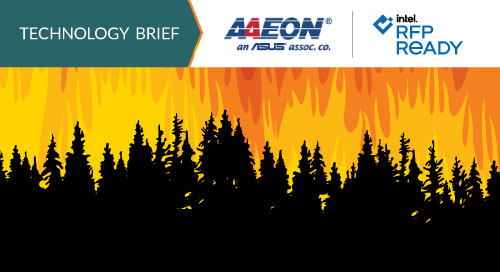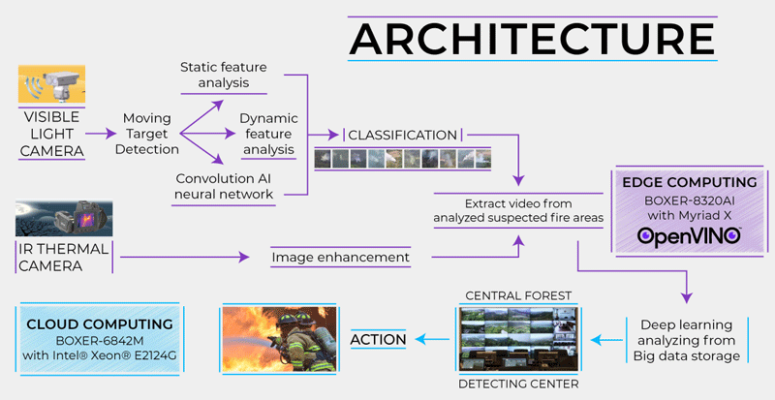AI Fire Detection: Computer Vision Guards the Forest

In the age of global warming, forest fires are becoming more frequent and faster-growing. In California, for example 8,619 wildfires in 2021 scorched 2.7 million acres, destroying more than 3,500 structures and causing billions of dollars’ worth of damages.
Clearly, the world needs sustainable solutions to preserve our natural resources, protect human lives, and avoid economic devastation. As an environmental advocate and sustainability enthusiast, I got to thinking about whether a technological solution can help with this daunting task. Fortunately, I am also a computer scientist, one who is all too aware of how tedious and time-consuming research can be.
Computer Vision Keeps an Eye on the Forest
In such times, I often choose to play my ace in the hole by going straight to Intel’s rich ecosystem—the Intel® Partner Alliance. Not surprisingly, it led me to an ingenious solution: the AAEON Intelligent Forest Fire Monitoring System (Figure 1).

Deceptively simple, the solution consists of cameras capable of monitoring a large area, detecting smoke, and activating an alarm. Yet on closer analysis, its innovative architecture makes it a technologically advanced solution.
AI Fire Detection Cuts Through the Fog to Detect Smoke
Indeed, image processing is done locally (near the camera) through an edge computing device. This industrial-grade computer analyzes images from dual video cameras–one for visible light and the other for infrared–and identifies any signs of smoke. If the system detects smoke, it immediately activates the alarm for central operations to alert local fire departments.
To avoid false alarms, the device can distinguish between smoke and fog. Let that sink in for a minute. The system has been trained to recognize fog, so that it cannot be fooled.
The AI can predict the direction and speed at which fire will spread—and alert relevant fire departments in advance. @AAEON via @insightdottech
All of this is made possible by the Intel® Movidius™ Myriad™ X Vision Processing Unit. This extraordinary processor performs image analysis through a specialized architecture that can perform deep-learning inference on a remarkably low power budget.
Central Monitoring and Prediction for Firefighters
Among other benefits, the ability to process video at the edge reduces the amount of data that must be sent to the central operations center—an important consideration given that many of the cameras will be installed at remote locations with limited network connectivity.
Once at the data center, images from all cameras are jointly analyzed for a forest-wide perspective of all fire activity. What happens next is truly amazing. The system can predict the direction and speed at which fire will spread—fully accounting for environmental factors such as wind and humidity. Next, it alerts relevant fire departments in advance to give them time to evacuate residents and try to contain the spread.
Already exceptional, the system takes it a step further by storing data and using it for iterative improvements. That’s not a surprise considering that AAEON is a leader in AI for the real world.
At this point you may be thinking: But how much does it cost?
Anything other than cost-prohibitive or exclusive, to be honest. I was surprised when AAEON’s executive team showed me the total cost of ownership. Instead of digits followed by a seemingly infinite series of zeros, the cost of the system and subsequent management is quite modest considering its ability to safeguard human life, the natural environment, and foster sustainability.
Using AI to Meet Global Goals
The AAEON solution illustrates the many ways we can use the powerful predictive influence of artificial intelligence at our fingertips or in technological proximity where local intelligence is required. This seems to be the future that awaits us, humans and artificial intelligence together to build a better future for us and our planet.
It is a shared goal of world leaders to such an extent that many governments feel the need to create a shared platform to explore and mitigate the disruptive impact of AI on society and the economy.
In Europe, for example, the AI4EU project was launched to harmonize, equalize, and promote innovation and technology transfer. I have been honored to be involved with this project as an external expert on the evaluation committee, giving me a front-row view of the ways AI can be used for good.
Returning to my central narrative: There is a strong sense in which the fire detection system is a manifestation of sustainability, insofar as it prevents CO2 emissions from forest fires; avoids overconsumption of electricity by transmitting all data to mega computers in the cloud; and is universally accessible by developing and developed countries alike.
In a word, it has the power to engage each of us in a sustainable movement to protect our one and only planet.
This article was edited by Christina Cardoza, Associate Editorial Director for insight.tech.
This article was originally published on February 25, 2021.